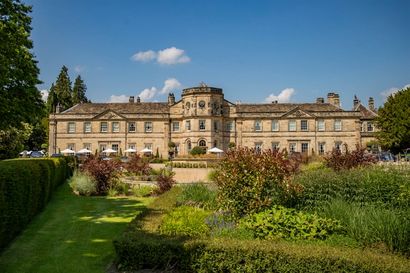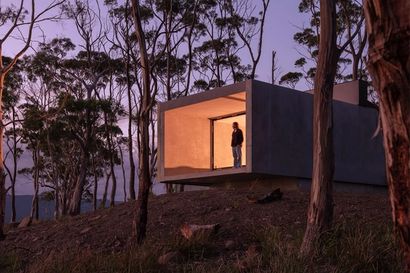The chief task of any semi-respectable hotel is to relieve you of the sting of everyday life with its small, almost indiscernible details: the slight of hand as the lobby boy sneaks away the Globe-Trotter from your hold, like some back alley pickpocket with a Windsor knot and frequently buffed Derbys; the heft of the heavy-set keys in between fingers and palm; the bed large enough to swaddle England’s forward pack; interiors flooded with more marble than that used for a Roman monument; and infinite supplementary hallmarks – the thickness of the bar tumblers, perhaps, or the purity of cotton weaved into the bathrobes – designed to make you feel as though you warrant a type of service only holy icons would know.
In Claridge’s, The Lanesborough, and The Dorchester – the Park Lane juggernaut where Elizabeth Taylor and Kate Moss once laid their heads on the soft, gentle pillows upstairs – London has ownership of some of the world’s best-known stays, ones that offer a pretty fine release from your emails and your deadlines, even for just a fleeting night or two. With the Mandarin Oriental, which first set up on the fringe of Hyde Park in 2000 and opened the long-awaited Mayfair follow-up in 2024, Raffles and The Peninsula, the city has been flavoured with a high-roller international touch, creating a well-rounded hive of destination stays. Boutique protagonists, such as NoMad, meanwhile, will give you a sceney, home-away-from-home experience. Below, we’ve rounded up a selection of the beds we like to dive into when in need of a breather from reality.
Mandarin Oriental Mayfair, London
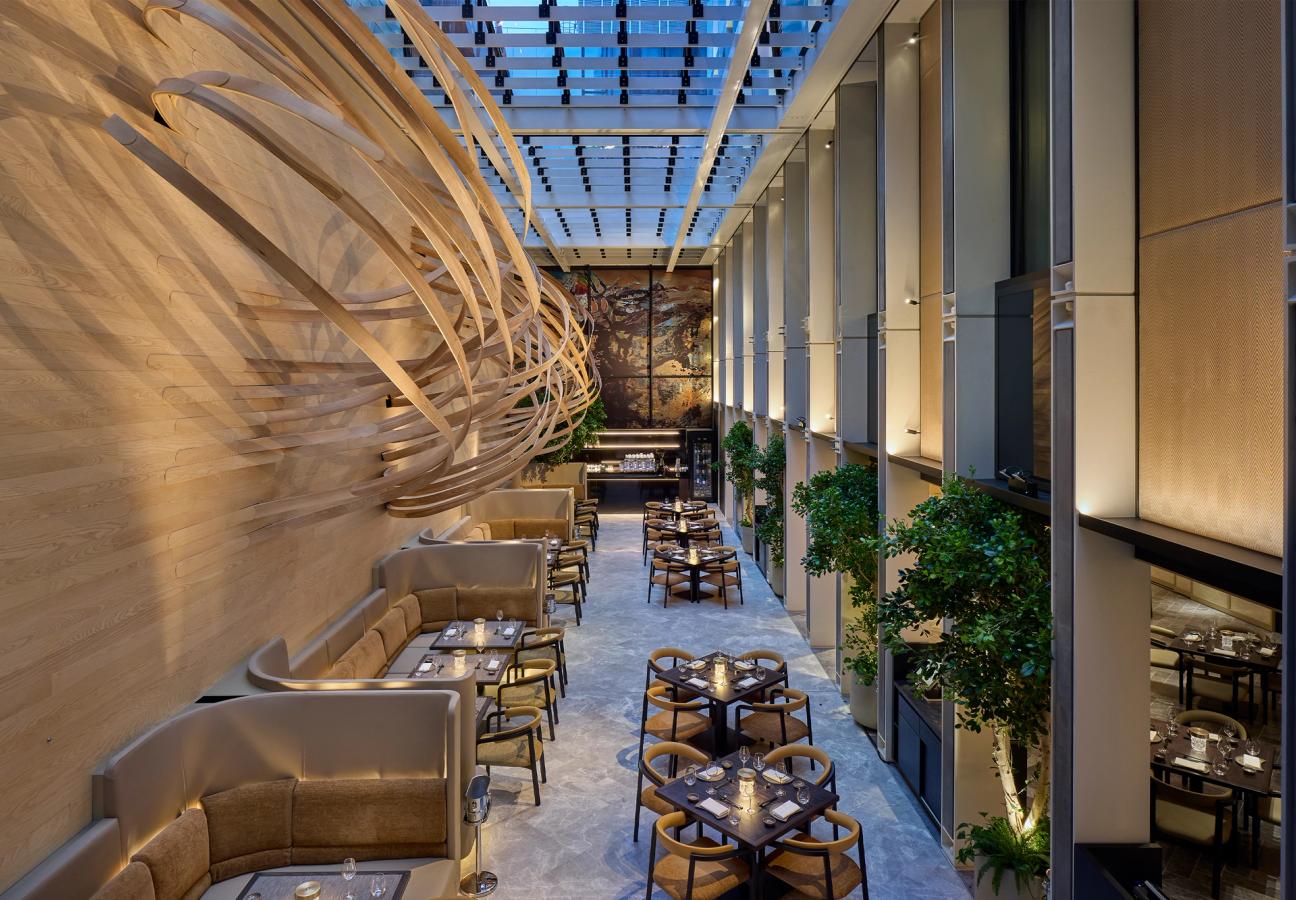
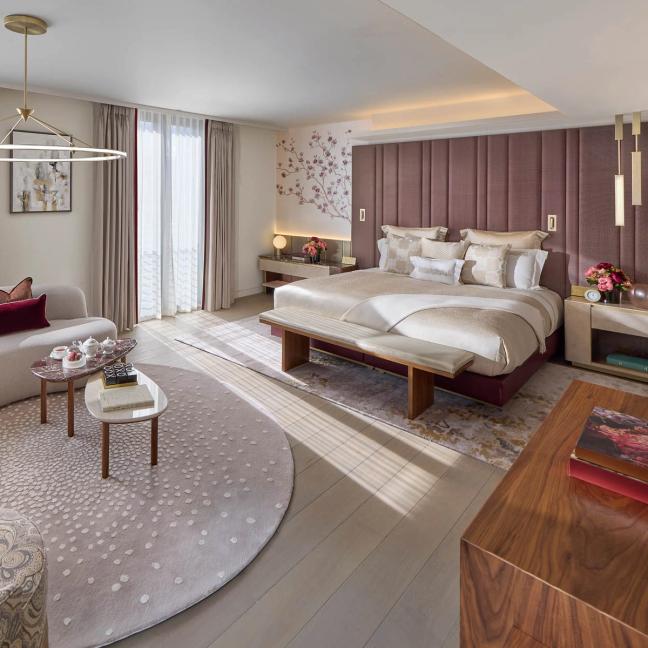

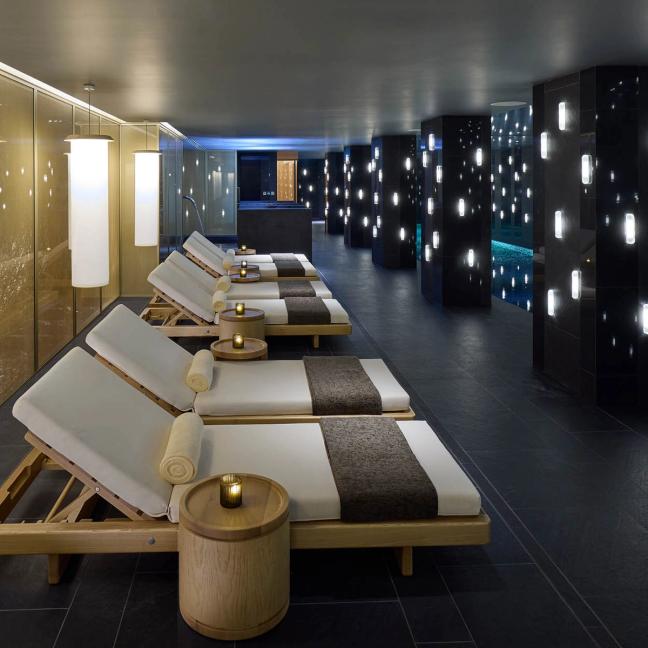
Those who’ve lived in London for a certain number of years will likely only know Hanover Square – once the meeting point of the Condé Nast workforce, a small, pleasant plot of grass and a neighbouring gallery or two – as a construction site that seemed like it would never rid of the fencing and the hazard tape. Of recent times, though, the magazine staffers have vacated their famous HQ, the Elizabeth line commuters slowly flow into this part of town at the end of the working day, the plaza has been brushed up, and the keys to the city’s second Mandarin Oriental, slotted neatly onto the pavement, have finally turned. There is more of a boutique spirit here – the shell of the property is slender and long, unlike the sizing of London’s older stays, and there are 50 rooms and suites, whereas its Hyde Park counterpart has little under 200 options – and, despite the brand’s six-decade existence, there is still a vibrant glimmer in the details, from the cherry blossom embroidery on the staff uniform and the pads inspired by the neighbourhood’s haute couture boutiques to the swimming pool that twinkles with a small universe of lights, as if it were a corner in a Yayoi Kusama installation.
The statement fixture is Akira Back’s restaurant, where there’s a smooth flow of Japanese-Korean creations, such as tuna pizza dabbed with umami aioli, small cuttings of shiso and a drizzle of truffle oil; and the Dynamite Lobster that breathes with the soft warmth of green chilli. There’s a vortex sculpture of laser-cut timber affixed to the wall in a hat tip to the elements, the artwork of the chef’s mother is pinned towards the back, and it’s supplemented by an adjacent speakeasy where the juicy cocktails really take the edge off. If you can afford the time, and if you’re suffering from a bit of post-retail trauma following an afternoon on Regent Street, submerge yourself for a half hour or so in the spa area’s vitality pools.
- 22 Hanover Square, W1S 1JP, mandarinoriental.com
The Dorchester
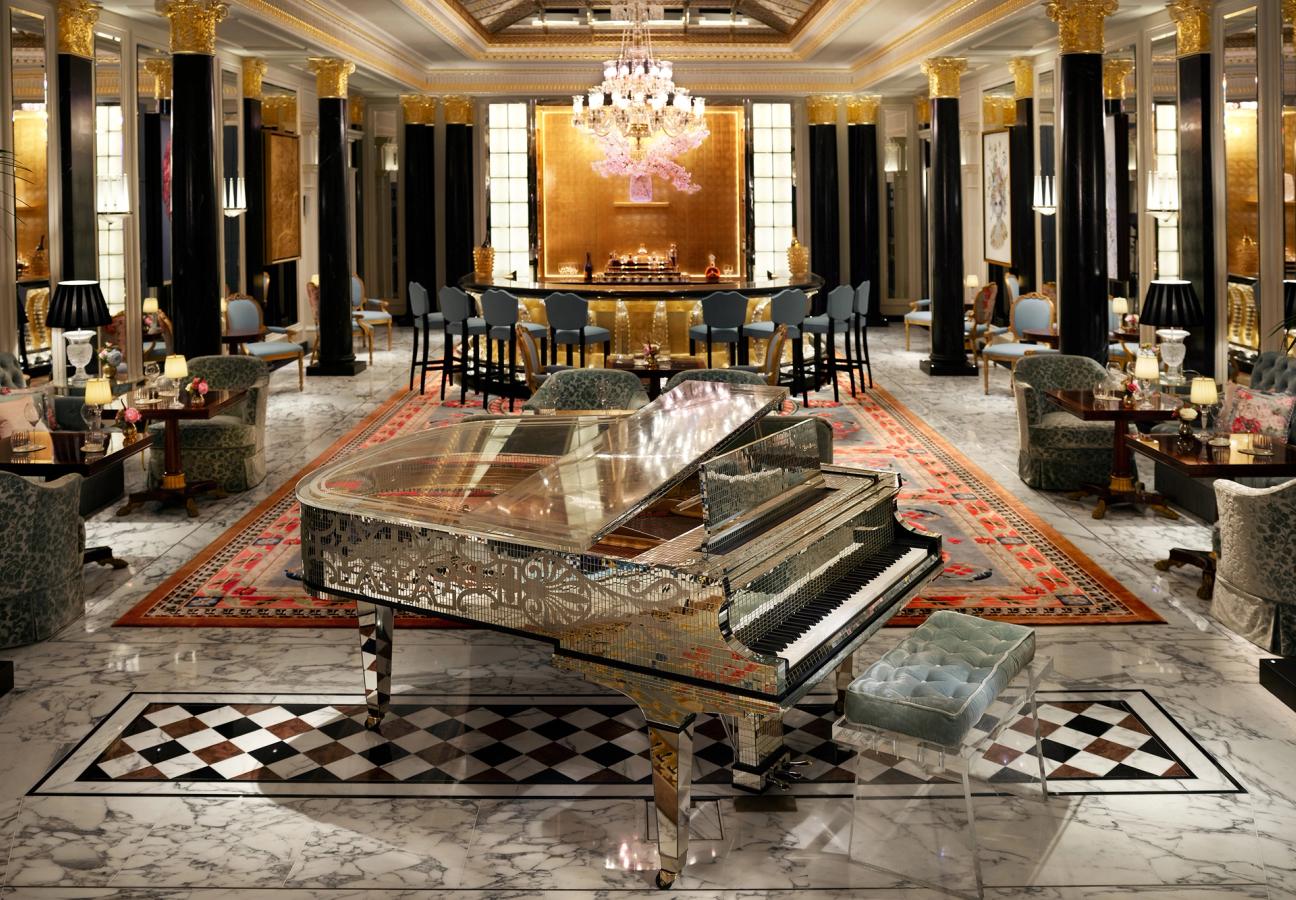
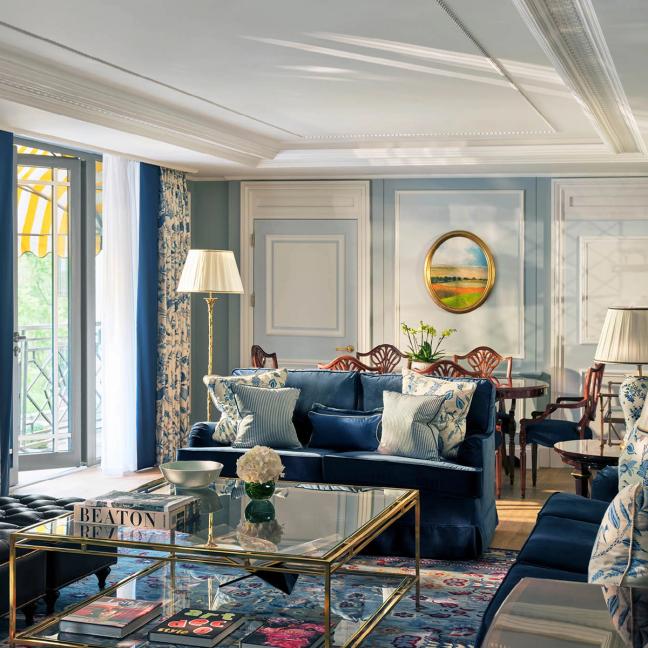
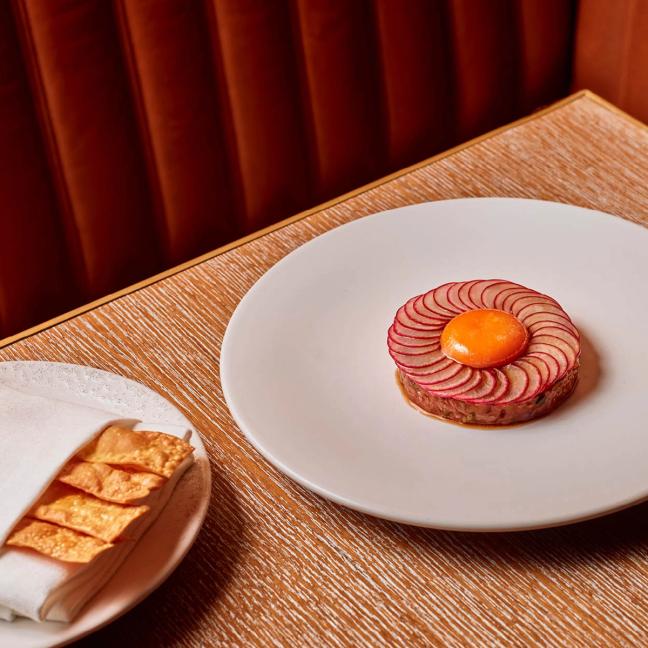
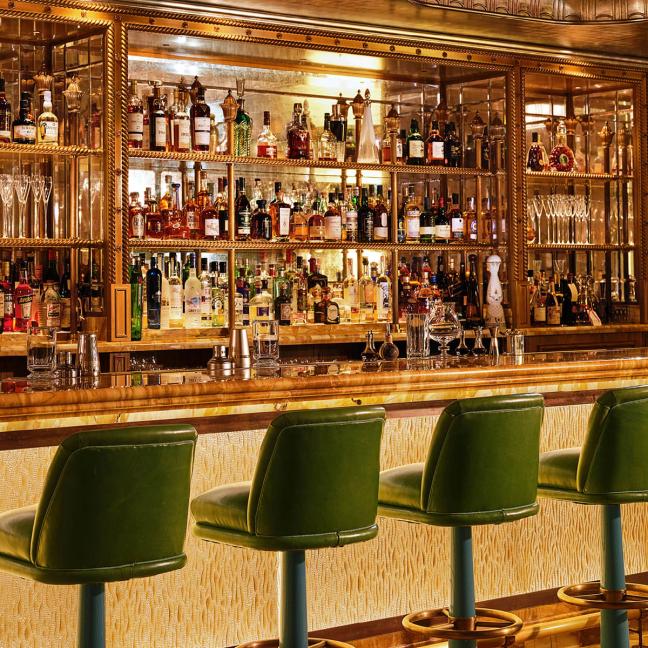
Once you pull your case through one of the revolving doors, the landscape in front is exactly what you imagine when you picture the high-art of London hospitality, a sort of Titanic on land, if you look at it a certain way: a lobby tall enough to fly a kite under; the elegant flow of sharply tailored service staff; and at The Promenade – the hotel’s spirited heartbeat and its food-and-drink lynchpin – designer Pierre-Yves Rochon has scoured out the previous scheme and loaded the space with streaks of statement rugs; glitterings of gold leaf; naturalistic artworks; and seating that appears to have been lifted from a Marie Antoinette moodboard. At the back is Liberace’s mirrored piano, the ballroom is splendid, and the cocktails are good enough to make you forget their cost. It’s an old-crooner’s place, a black-tie sort of place, a place that’s more appropriate for runaway romantics than corner-banquette business.
In the floors above are the webs of corridors and guest rooms – there’s the light simplicity of the Dorchester Studio; the Belgravia Suite, dressed like a lush stretch of Hyde Park in front, offers a look over the armada of Ferraris and Bugattis that pull up to the front entrance; and with the Hyde Park Suite, you get the feeling as though you’ve stepped inside a bit of Wedgwood tableware, with the room’s interiors blasted with a Pantone book of blues. It is in the latter space where you get a superb London view – not of the palace, nor of the skyrise cityscape, but of a few peaks of park trees – a floorplan in which you can hit running speed, and tables that essentially encourage a few late-night card games. There’s much that can be done inside these attractive walls – yet, more often than not, the irresistible call of the deeply pleasant mattresses might limit your productivity.
- 53 Park Lane, W1K 1QA, dorchestercollection.com
Claridge’s
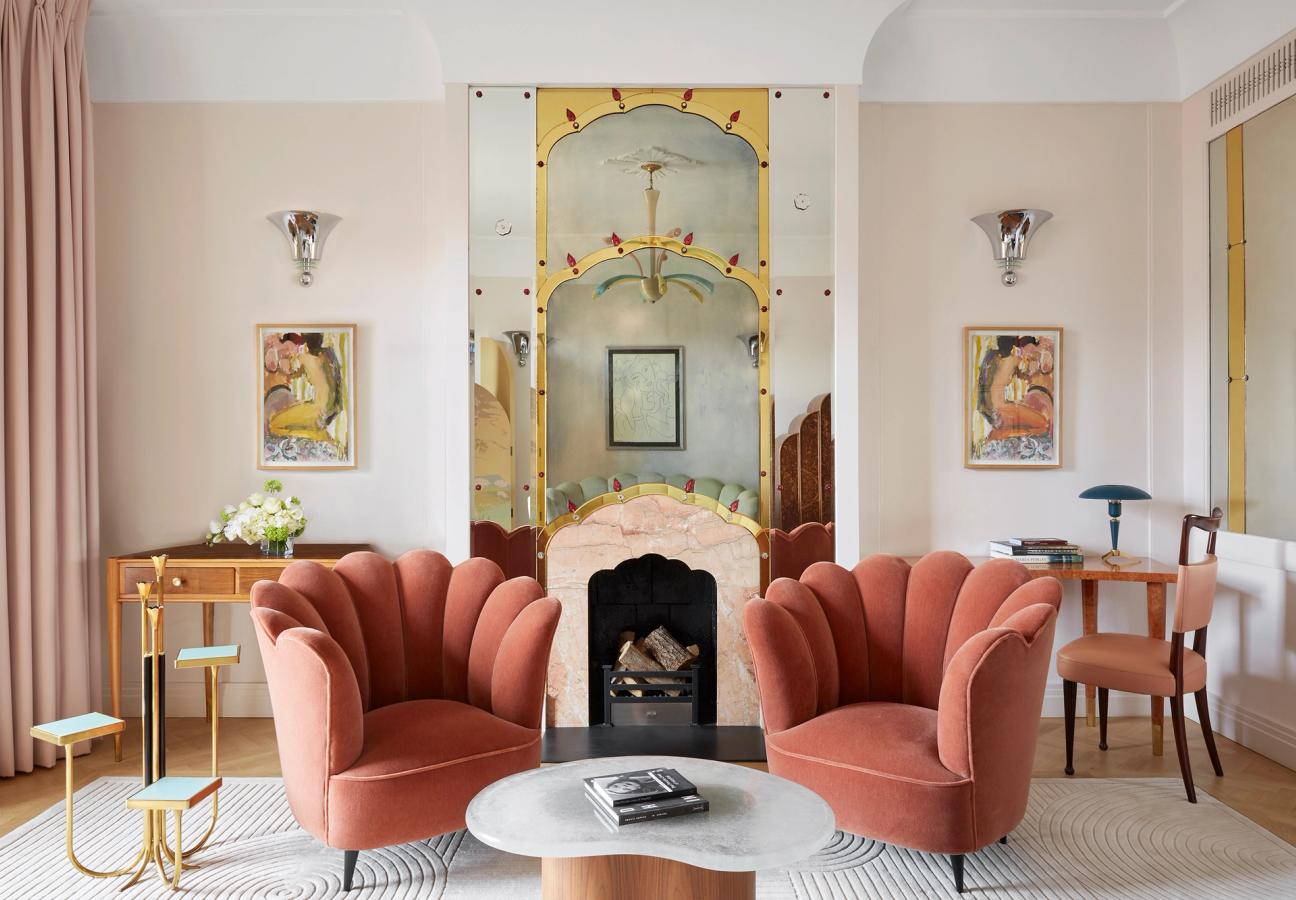
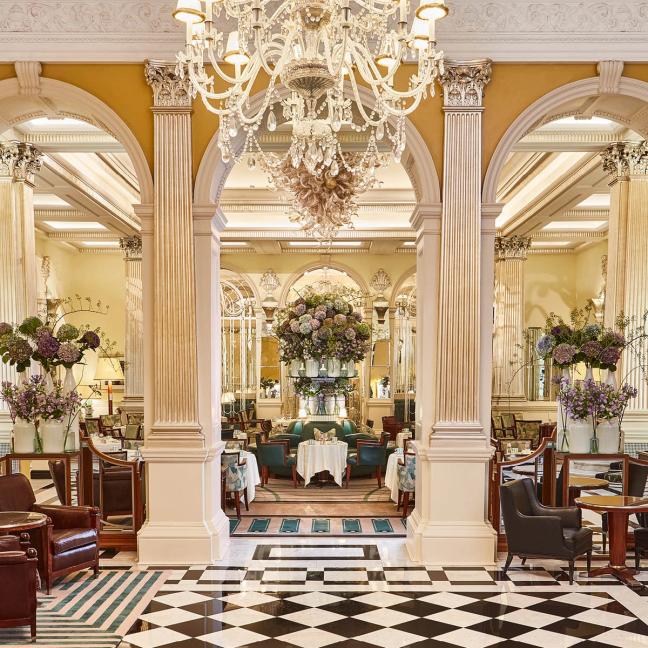
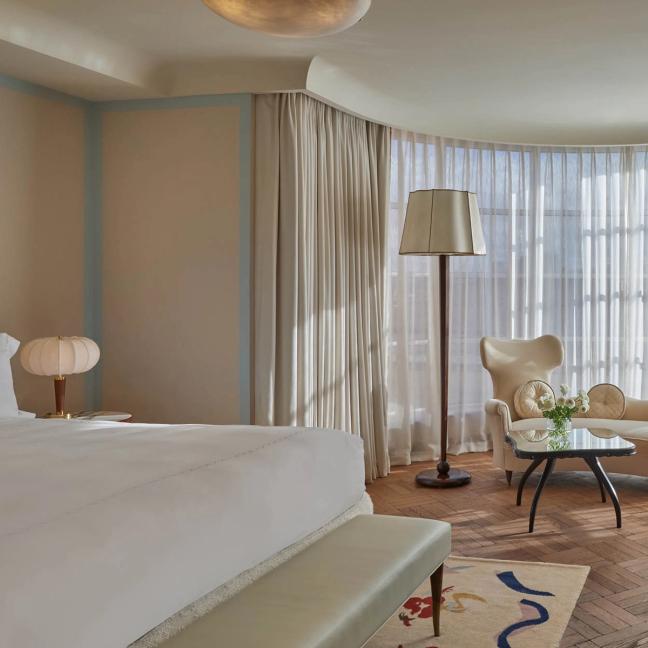
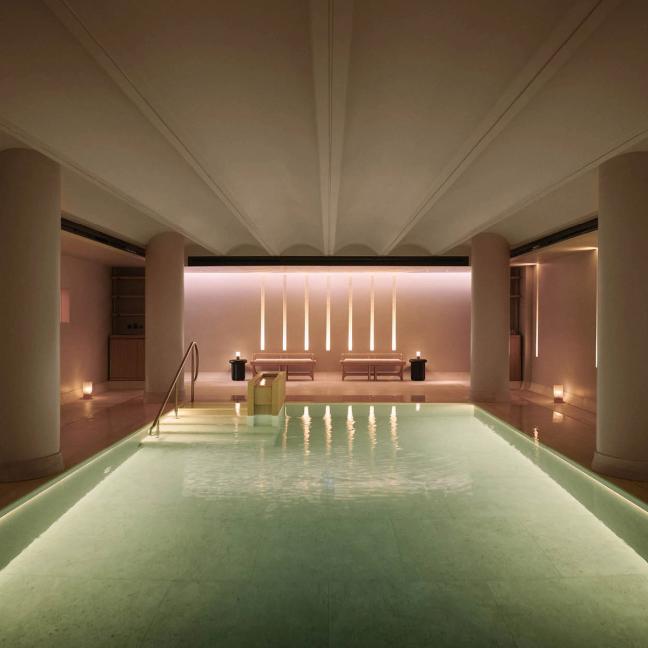
Since at least 1856, when the first guests poured into the lobby, Claridge’s has been the deep envy of hoteliers across the world. Its fusing of high-tea with quality bedsheets, costly lighting and fleets of doormen has made its legend as a British stay straight from central casting, its crowd of well-shined Oxford lace-ups and the checkerboard foyer coalescing together to form a suave, art deco ecosystem.
The trick here, really, is to avoid exploring the neighbourhood – the pull of Mayfair and The Audley Public House and a quick trip to the Hermès boutique may be strong, but you must resist! – and invest a day or two doing a reccy within. Foremost among the lineup of draws is the namesake restaurant, taken back in-house after years of being steered by flagship names, such as Gordon Ramsay and Daniel Humm. You’ll find seafood towers, steak au poivre, Parker House rolls that bloom like a spring morning. The hotel also specialises in great drinks – The Painter’s Room, a soft-pink cocoon of a space, is beloved for its fruity mixes – and you’ll also likely need to pencil in an hour scrubbing it all away in the André Fu-designed spa, where the wisps of burning sage are meant to evoke the kind of stillness you’d find in the most hushed corner of Kyoto. Alternatively, do not be shy about staying inside your room – The Mews Pavilion is perhaps the call of the moment – and dialling up room service. Consider it bad taste if you fail to order the fried chicken.
- Brook Street, W1K 4HR, claridges.co.uk
Raffles London at The OWO
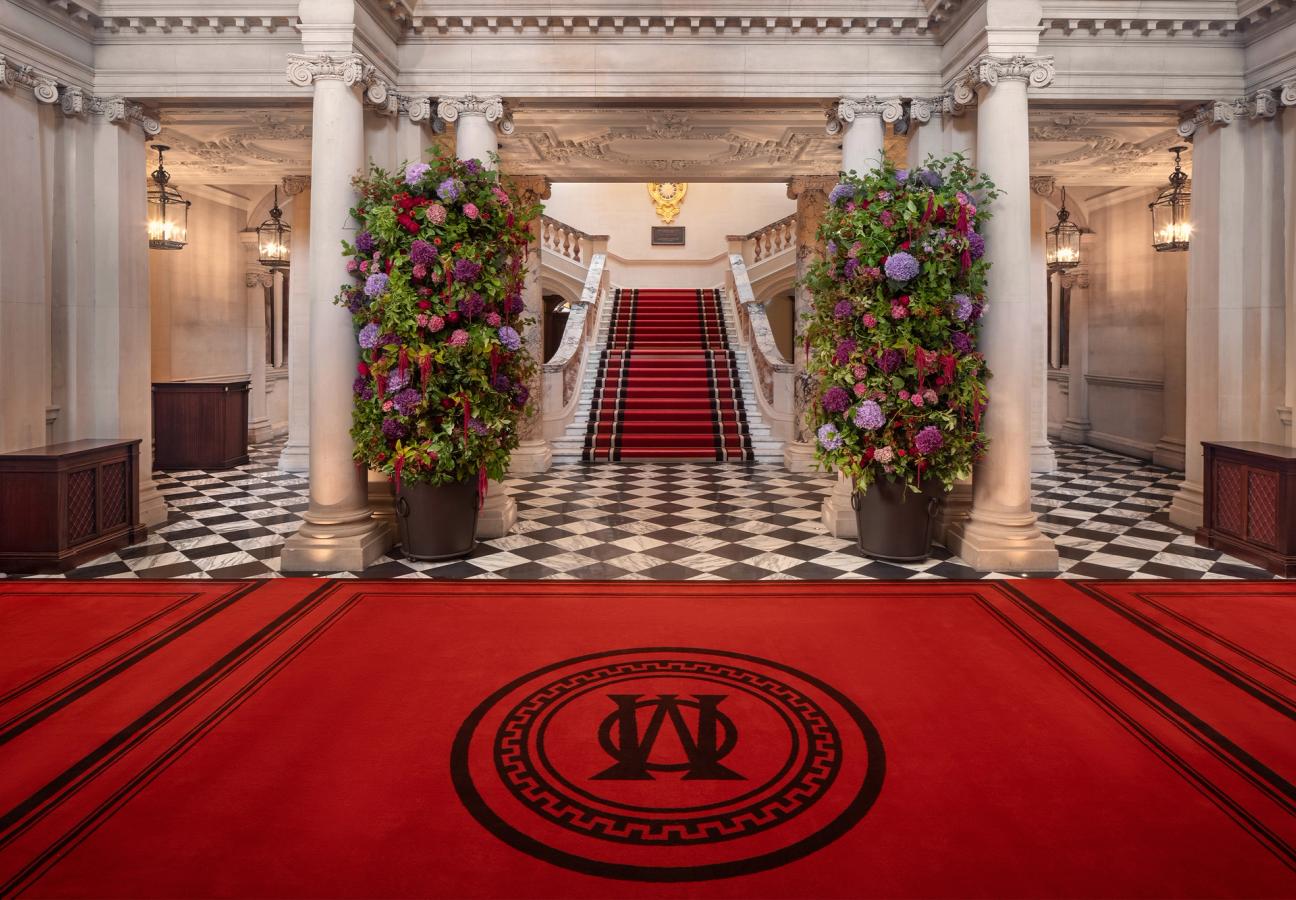
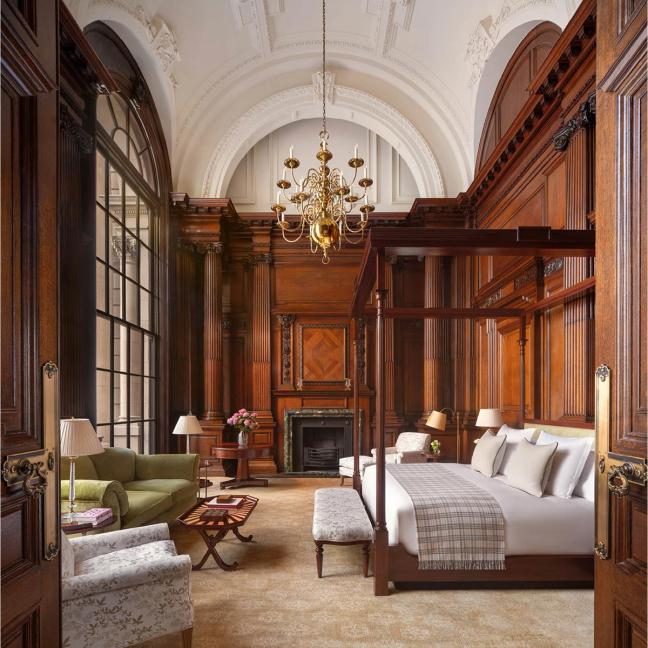
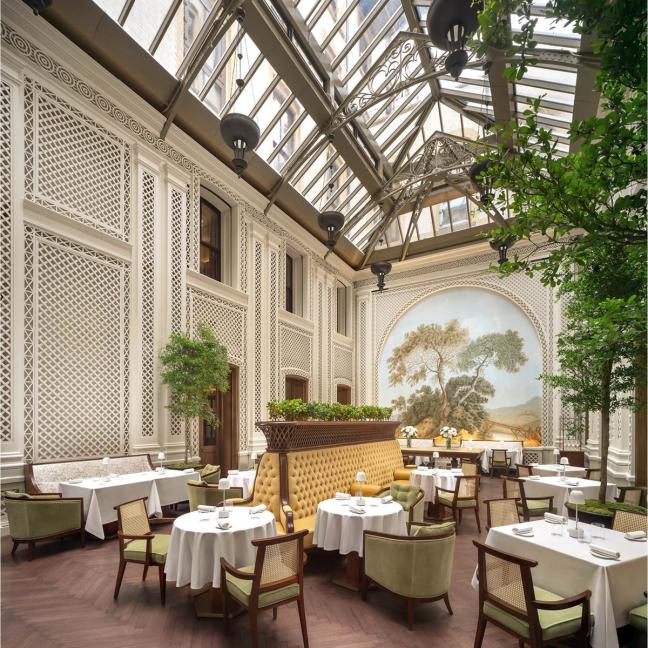
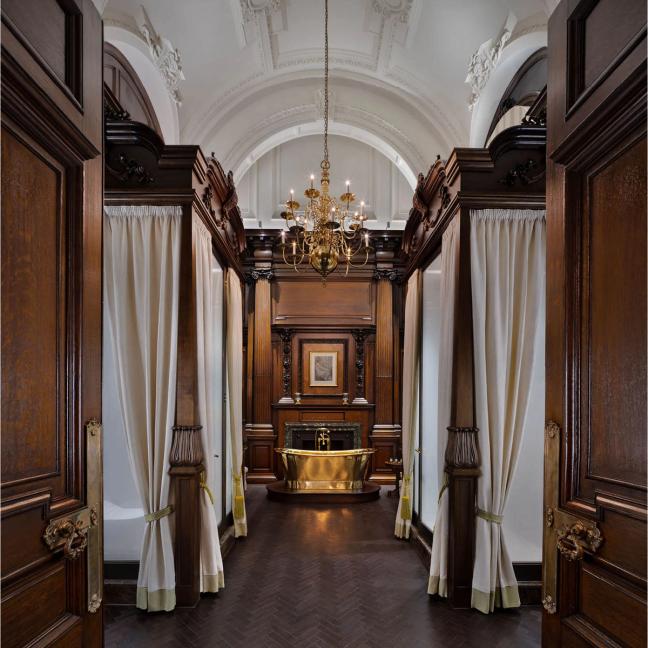
The London satellite of Singapore’s flagship hotel really is a turbo-charged leap forward for the capital’s hospitality scene, with its statement Edwardian Baroque exterior of palace proportions, two-and-a-half miles of corridor winding around, an astonishing staircase fortified with veined Italian marble and Painswick stone, and a trapezium footprint that goes seven floors up and seven floors down. The remains of the one-time Old War Office – Churchill’s base of command, and the place that incubated MI5, MI6, and the creation of James Bond – are still evident, as the six-year-long, near-$2bn renovation made sure not to wash out the original checkered-floor foyer, the sharp mouldings and precise cornicing, the beautiful mosaics and panelling, and the Army Council Room, the location in which WWII tactics were shaped. An exploration of the property is a matter of both ogling and endurance – an eye test and a history seminar married into one.
Among the slew of accommodations (options such as the Executive room and the Ministerial Suite have the light, breezy quality of a countryside residence), you’ll likely note The Granville Suite, where there are giant oak casement windows, and a free-standing brass tub that appears as if it were an installation in the Tate Modern. In the evening, settle in for a few hours at Mauro Colagreco, the flagship restaurant that, throughout the seasons, shows off more than 70 varieties of fruit and vegetables from the English countryside and its bucolic gardens. In the morning, breakfast takes place in the atrium-like Saison. If your game plan is to remain cocooned within the hotel’s confines and avoid the tourist hordes on Whitehall, try the subterranean pool whose magnificent four-level scale may bring to mind a Turkish bath. But the real move is to navigate the raw, below-ground hallways to locate The Spy Bar, the hush-hush nook where the vintage libations will drive your Amex to its limit. And you’ll likely yield. After all, you only live 00nce.
- The OWO, 57 Whitehall, SW1A 2BX, raffles.com
The Peninsula London
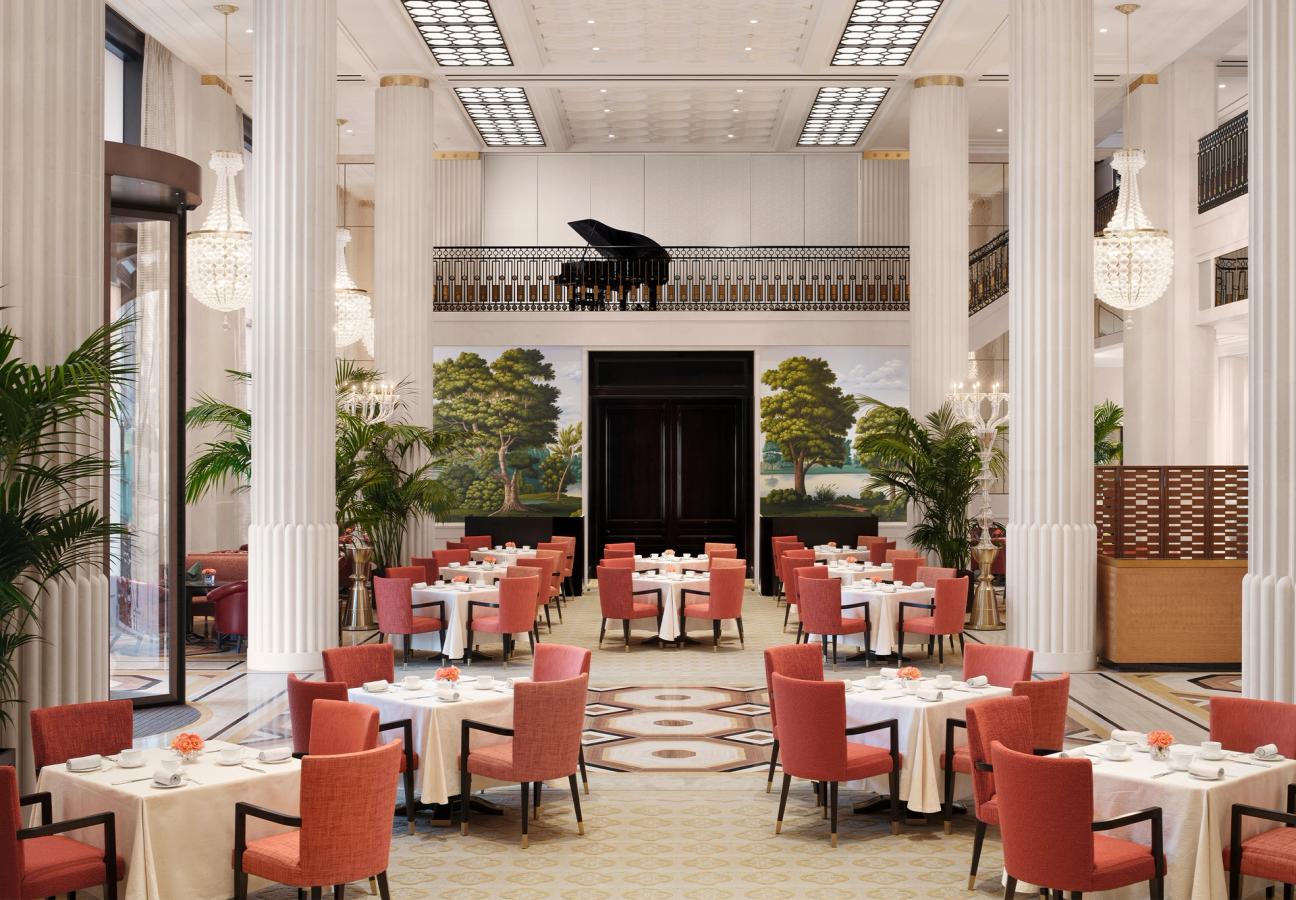
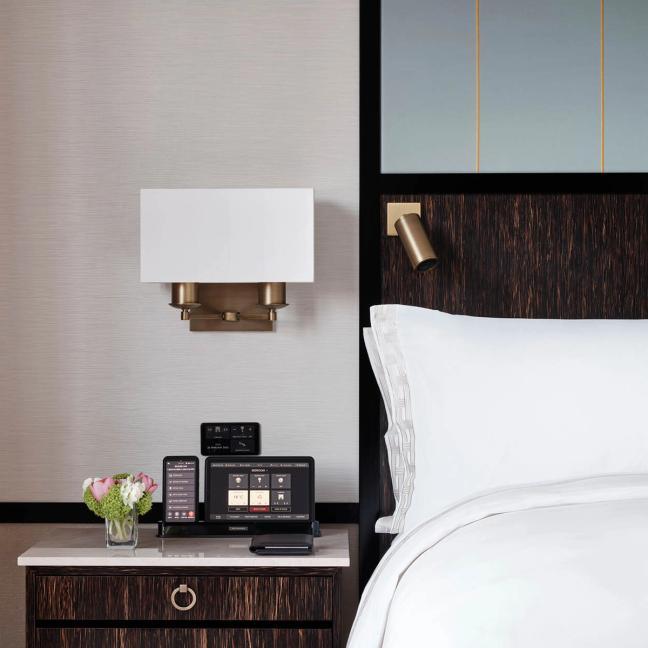
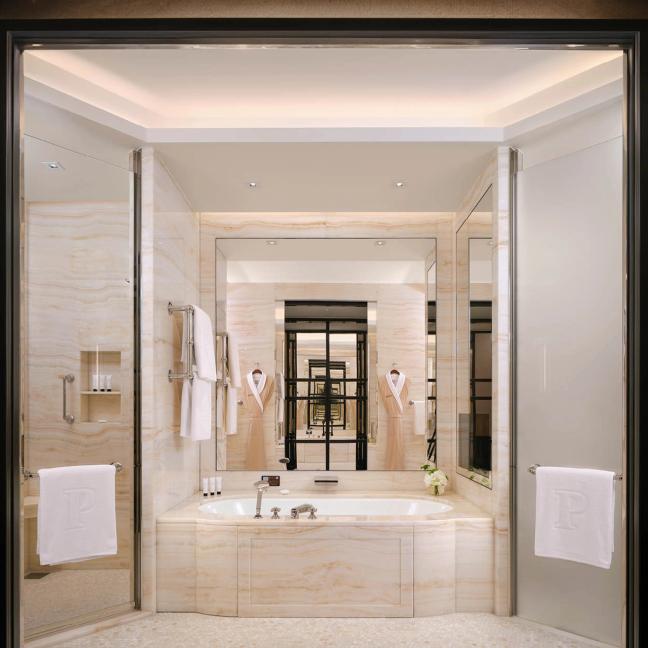
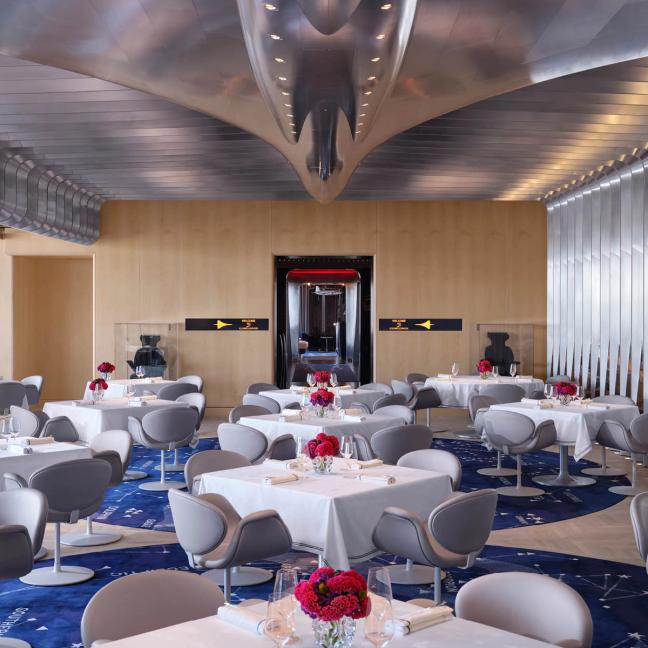
For a couple of generations now, The Peninsula – which has a storied pedigree that makes it tied to Asia’s oldest string of hotels – has essentially been a second home for those of a particular pay band, originally admired for its squads of dutiful page boys in pillbox caps and worshipped nowadays for its assembly of green Rolls-Royces out front and its vast expanses of space decorated with enough art to fill a decent size Gagosian. The sweep of in-room tech syncs you into the property’s wonderful matrix – The Peninsula, in many ways, is a pretty decent alternative to a GAFA headquarters – as do the staff who beam at you as if you are the only man on Earth; after a few nights here, you start to understand what it might be like to be Michael Jordan walking through Chicago.
It originally started in Hong Kong, towards the end of the 1920s, before fanning out across Asia, Europe and America, and recently came to London, in a behemoth new development off Hyde Park Corner with an almost entirely enclosed blueprint to make it feel as though nothing else exists outside the building’s graceful pleasures. The atrium at the centre of it all is large enough to host a Harlem Globetrotters exhibition and has the type of detailing – moulded ceilings, de Gournay landscape murals, tall pillars and big chandeliers – that might remind you of that time you toured the mansions of Bel-Air.
When the call of the room comes, the classic hallmarks of The Peninsula are all there, with bathrooms that are fitted with a sufficient amount of marble to deck out a Medici’s palazzo, and the valet box, a hidden drop-and-pickup cupboard for shoes needing to be shined and shirts yearning to be pressed, is just perfect for guests of an introverted nature. On the bedside, there are touchscreens that have you conduct the way the room operates: blinds, temperate regulation, alarm, channel of choice, and a call for a 3am club sandwich. And a 10pm check-out is all part of the package – you best not waste it.
- 1 Grosvenor Place, SW1X 7HJ, peninsula.com
The Lanesborough
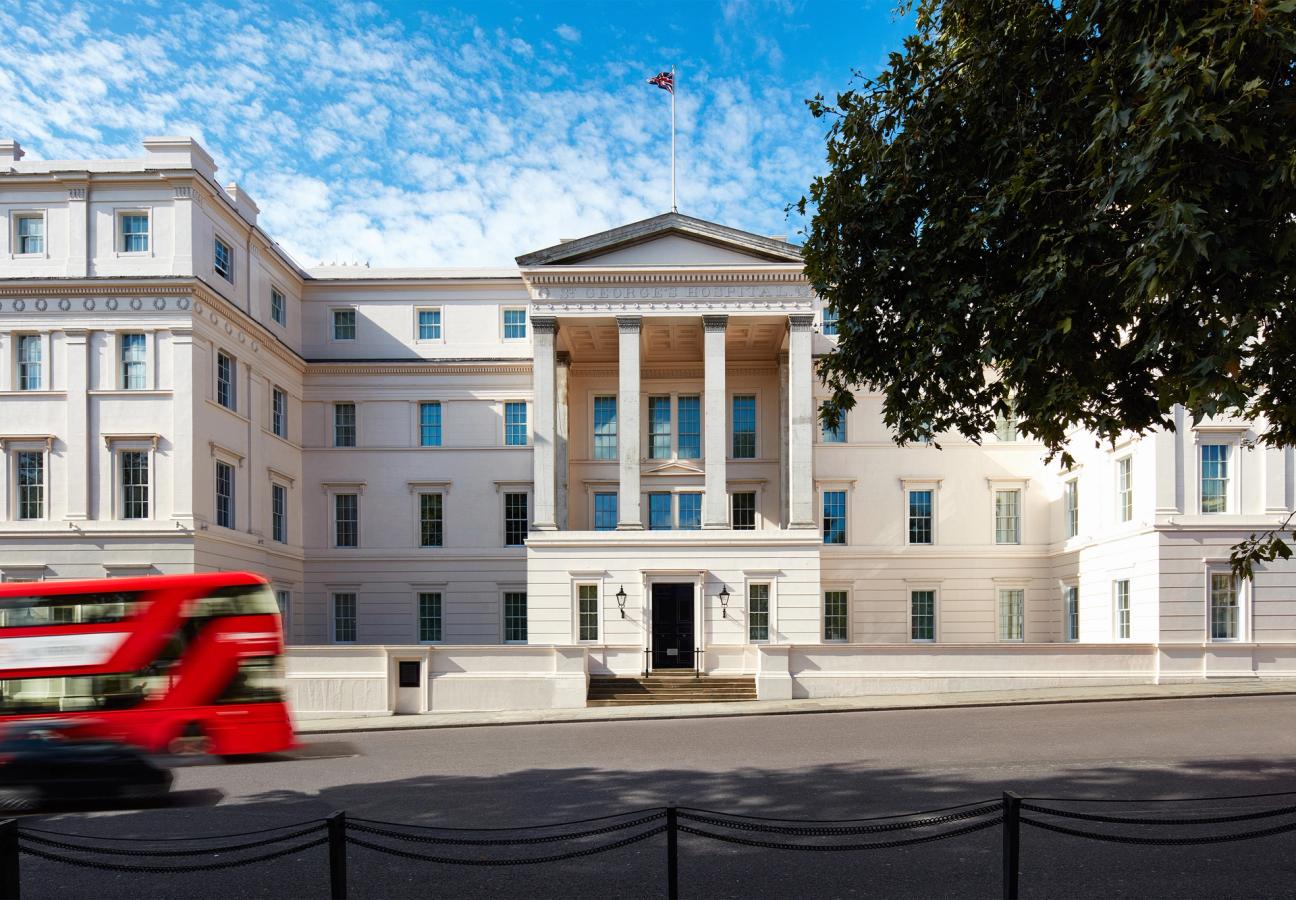
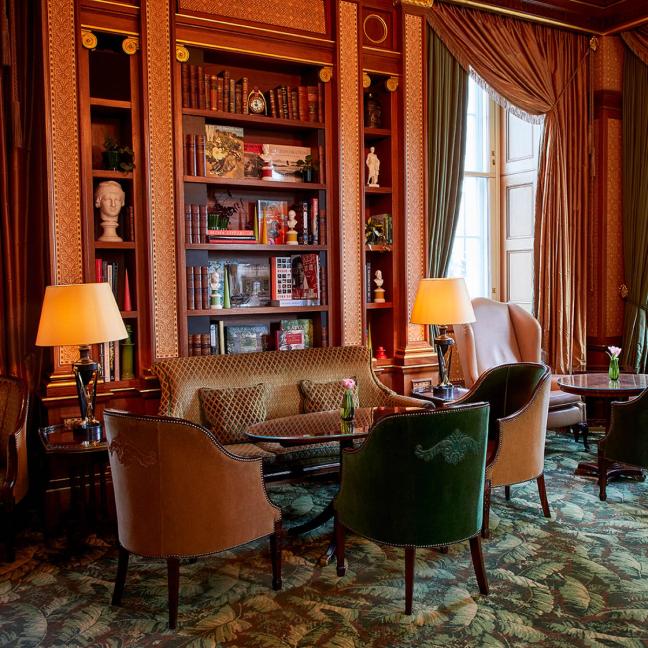
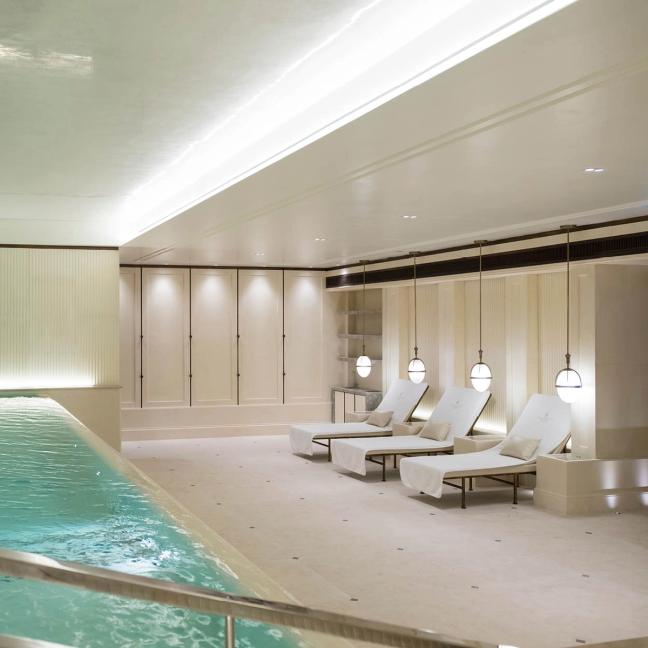
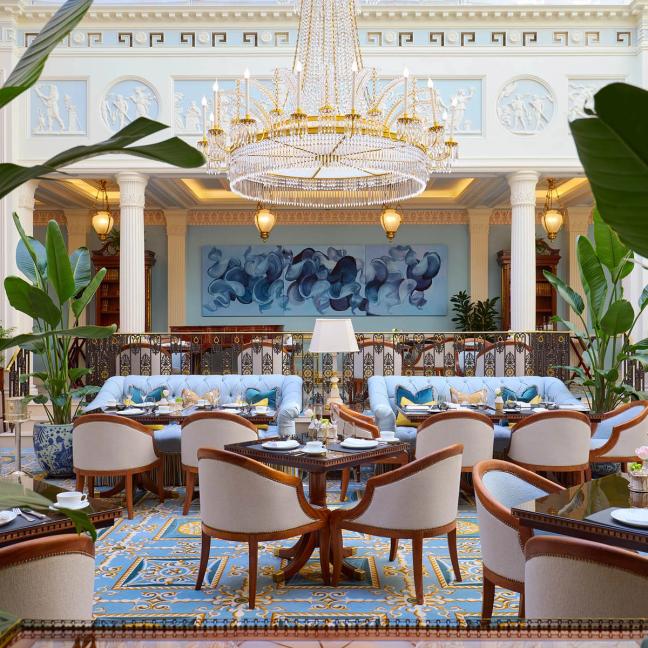
The Lanesborough, an 18th-century residence that was eventually reconditioned with Greek-revival stylings, is sat on what is now Hyde Park Corner – a jumble of red buses, Santander bikes and G-Wagens – and has been running as a hotel since 1991 (it was also a health service in a former life). There is no arrangement of standing check-in kiosks; instead, there is a pair of desks, which sort of bring to mind the type you’d see at a jewellers, or at a mid-century bank. This, I think, kind of says it all about what the hotel is trying to achieve: less institutional and more of a personalised experience, as though you’re making an investment with your time, the same with how you’d feel when purchasing a diamond, or opening a checking account. Moreover, there are no grand set-pieces – no waterfalls, no interventions by NFT artists – but, rather, the appeal is in the period detailing: the cornicing is exact, the curtains look heavy and proper, and the Belgravia Suite has been heavy-handed in its use of mahogany and features marble bathrooms flush with double sinks and soaking tubs. The feel, overall, is as though a Bridgerton set leaked all over the walls and floors.
The hotel’s moneyshot view – every good hotel requires a moneyshot view – is in The Lanesborough Grill, an atrium-like room that evokes an early-World’s-Fair setting, and the daylight that beams through the domed glass roof provides a nice, natural sheen to the clusters of cobalt- and sky-blue fixtures. From here, Shay Cooper, a chef who did turns sweeping up Michelin’s approval for The Bingham Hotel, in Richmond, and The Goring Hotel, showcases the best of the British larder. A starter of grilled octopus with pearl onions, slicked with romesco and flavoured with roast garlic and samphire, may fade into a dish of Hampshire venison, delica pumpkin, salsify, bergamot and grilled kalibos cabbage. One of London’s great fitness areas lies beneath ground, if you need to work it all off. The Library Bar, which bills itself as a ‘liquid museum’ of spirits, is where Stevie Wonder once played on the piano. And, there’s a house cat called Lilibet. Isn’t She Lovely? She is, indeed.
- Hyde Park Corner, SW1X 7TA, oetkercollection.com
Shangri-La The Shard, London
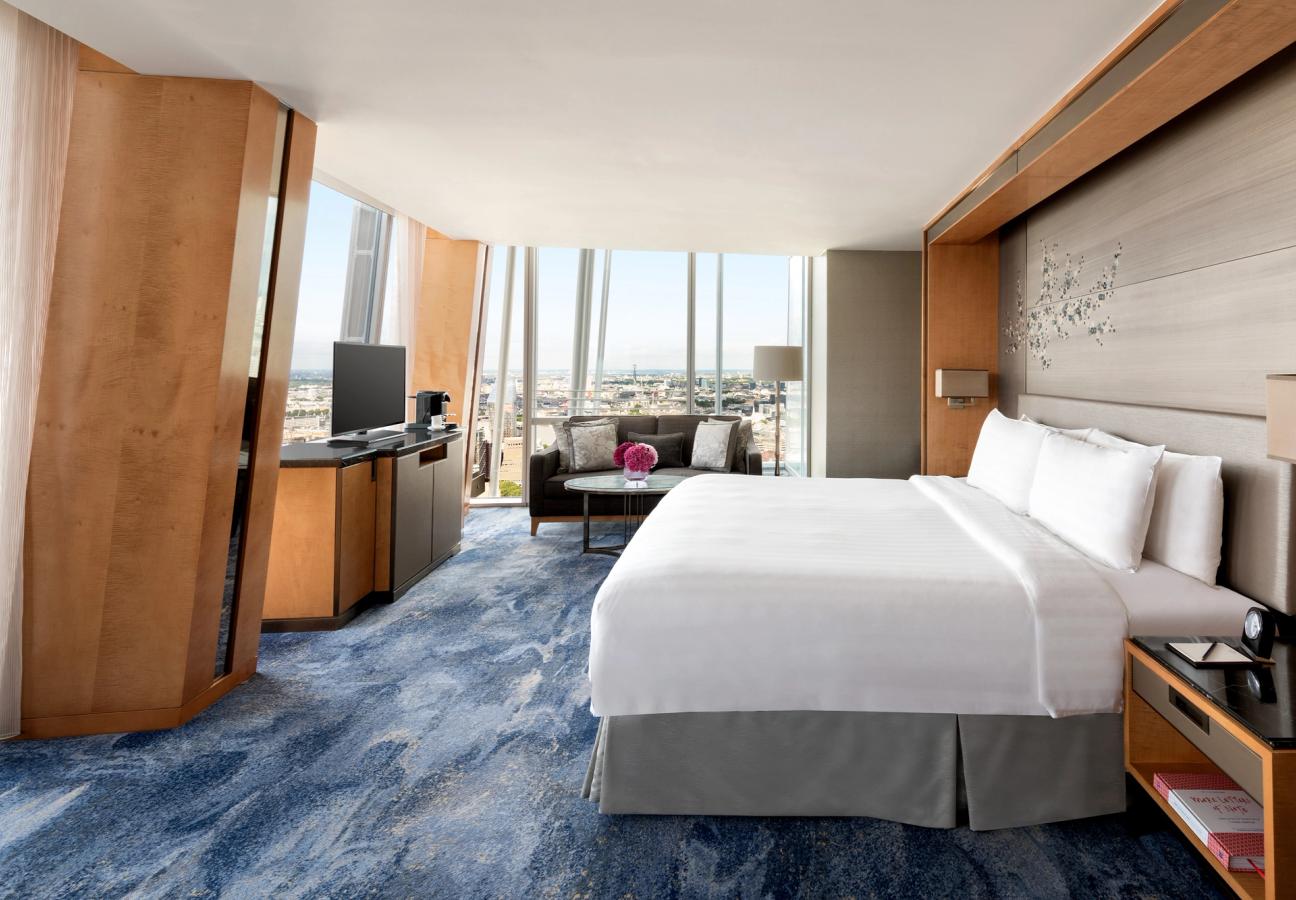
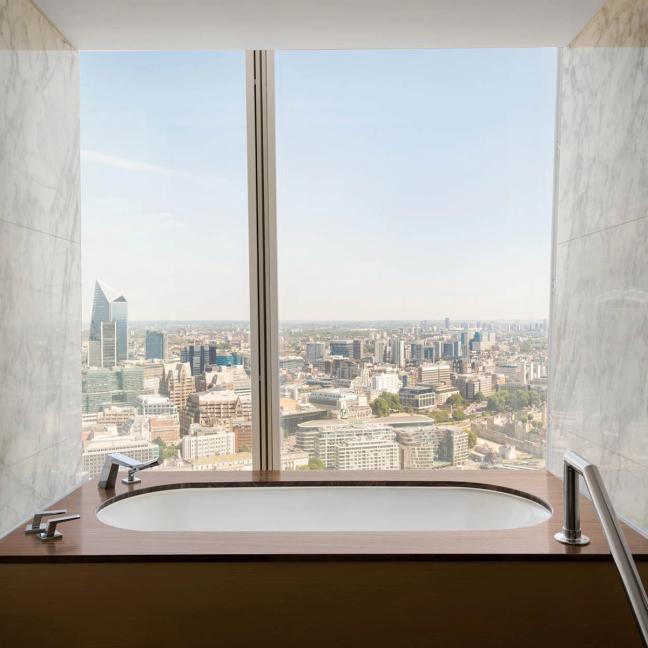
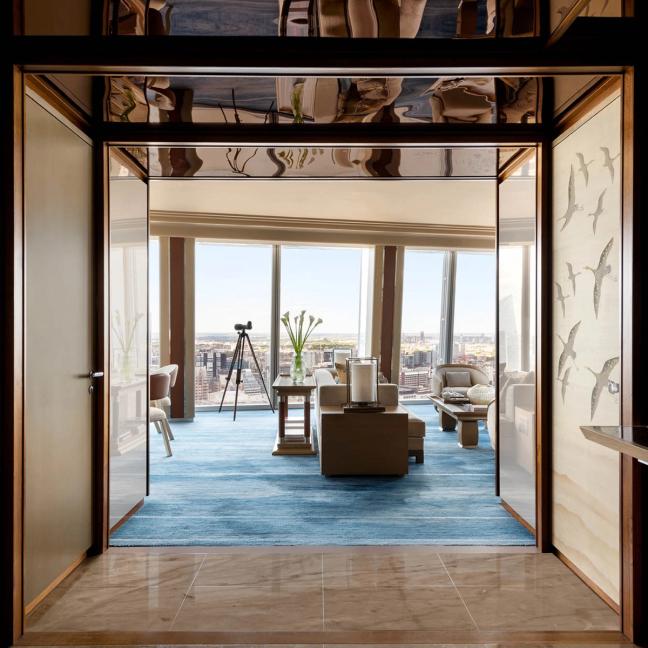
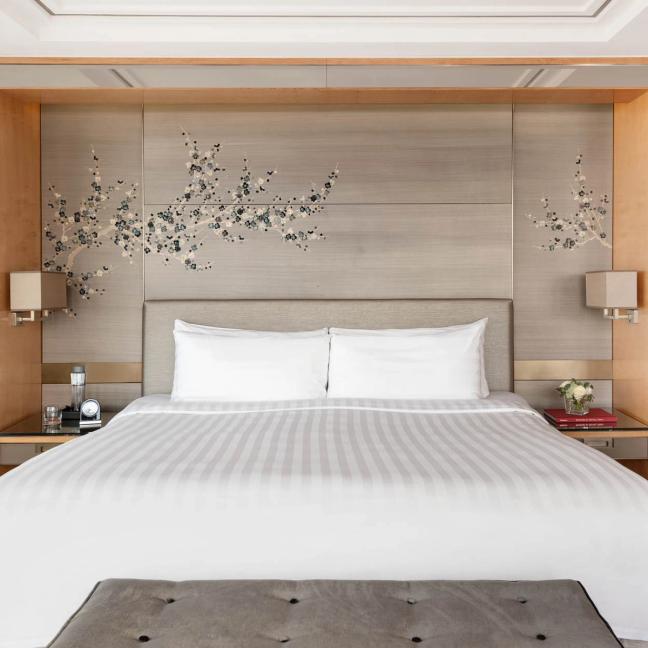
Even if its high-rise sprawl isn’t on the same scale as Manhattan or Hong Kong, London is still a city that reaches for the skies, its Walkie-Talkie, Scalpel and Gherkin some of its most noteworthy urban set-pieces. But buildings that stretch for the stratosphere tend to draw the snare of the critical – the corporate nature of it all, the moneyed gimmicks, the flash of selfies. Yet, once you get to the 34th floor of The Shard, Renzo Piano’s signature fingerprint on the capital, and are hoovered into the glories of the Shangri-La hotel, the empty novelties that a sceptic might expect are not there – but the views are, and as soon as the blinds are lifted as you enter your pad, you just submit to the picture in front: a never-ending hinterland of neighbourhoods and important buildings, the river that slices through it all, the wheel, the cathedral, London.
Though the hoteliers could’ve used the vistas as a crutch, they didn’t, opting instead for refined stays that cocoon guests with a soft palette of light wood and marbled bathrooms, and the culinary options are as razor-sharp as the building in which the bolthole is housed. In the evening, head for TĪNG, which proffers well-executed dishes from Asia – hits have included mapo tofu, Malaysian fried rice, and a pudding of mango with coconut sago – and in the morning, the buffet, which blends a western offering with dishes such as congee and pork dumplings, is a glorious way to fuel up before you head back down to Earth.
- 31 St Thomas Street, SE1 9QU, shangri-la.com
Mandarin Oriental Hyde Park, London
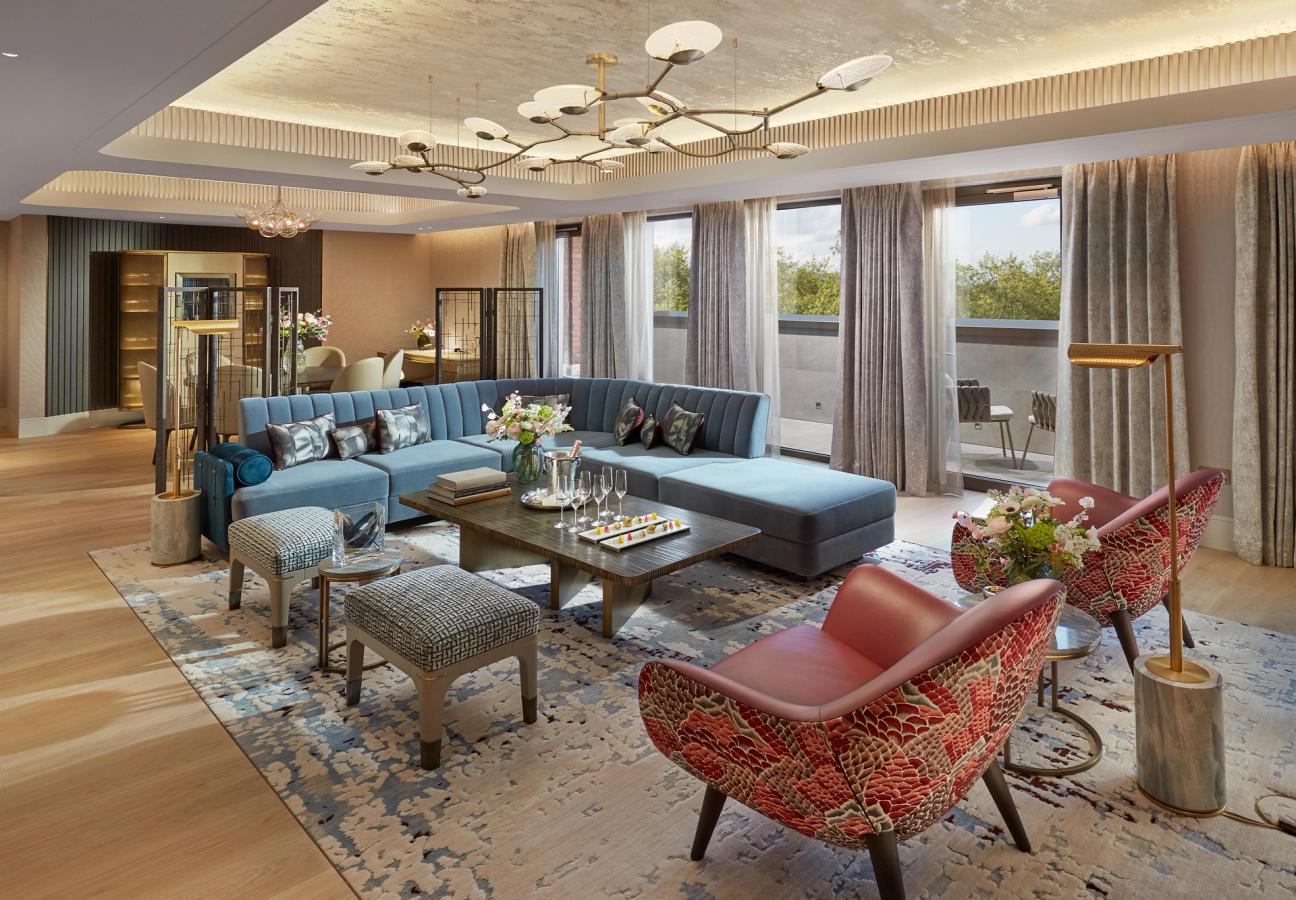
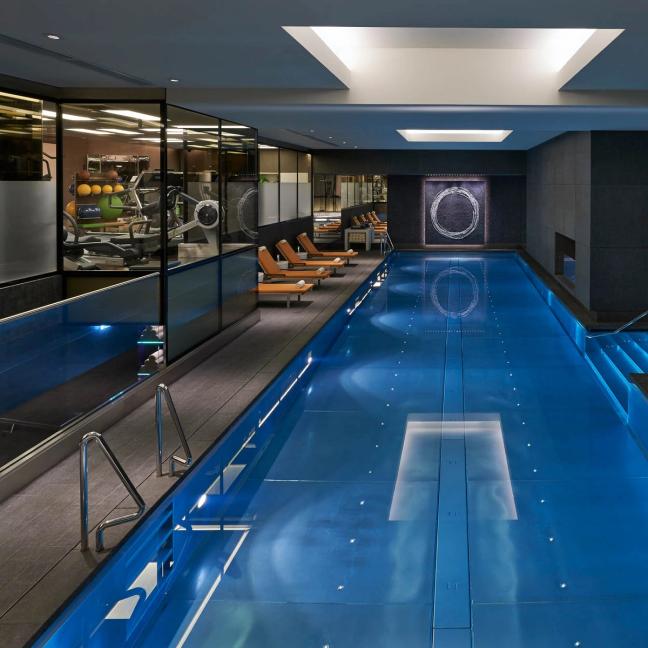
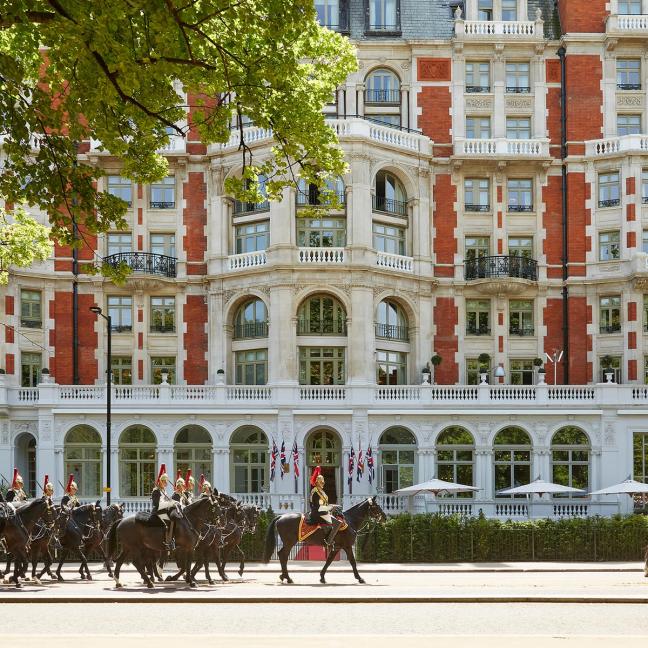
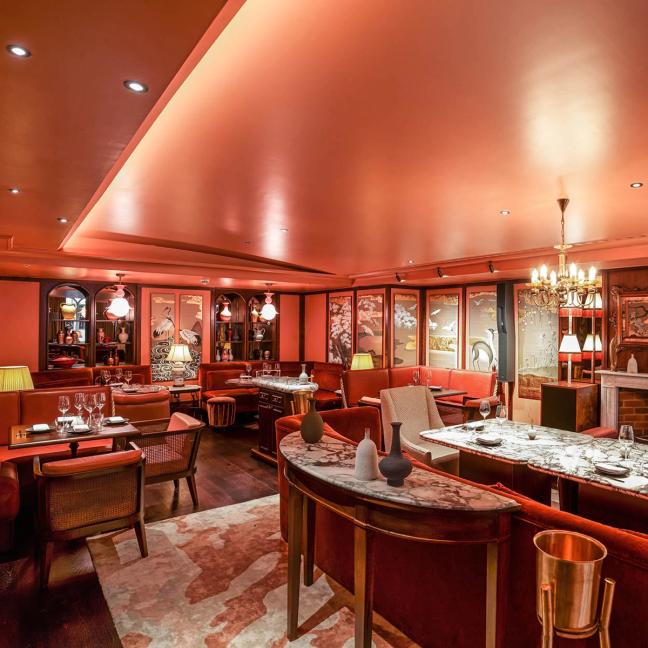
Across the world, each Mandarin Oriental is both a distant cousin from one another as well as a completely distinguishable site on its own, in style of location and feel, in both cuisine and sensibilities. Bangkok’s is on the banks of a river, Paris is set on an extent of the city’s high-end retail, and, at Bodrum, you have front-row viewing of the Aegean. In Santiago, there’s Nikkei fare; Macau has great dim sum. The Hyde Park option – with one side on Knightsbridge and the rear over a stretch of London’s most-known green space – splits the difference between the rush of city living and the calm rhythms of a Sunday-morning stroll.
Even with the 24-year-gap since its opening, we still can’t waver in appreciation for the place, with its propriety of The Aubrey, a sort of souped-up izakaya serving Wagyu sandos and spicy-hamachi crispy rice; its perfect terrace that’s soundtracked by the gentle hum of Bromptons spinning by; and Dinner by Heston, where travelling diners still jump for its fruit pâtés and lovely pineapple dessert. Though the red-brick shell creates a firm firewall between guest and the outdoors, Joyce Wang’s melodic scheme of wallpaper embossed with copper leaves, onyx fixtures, and green splashes emanates a peaceful bubble of naturalism. Some rooms come with a bottle of the MO scent, so that you can later perfume your own apartment with the fragrance of somewhere far, far better.
- 66 Knightsbridge, SW1X 7LA, mandarinoriental.com
NoMad London
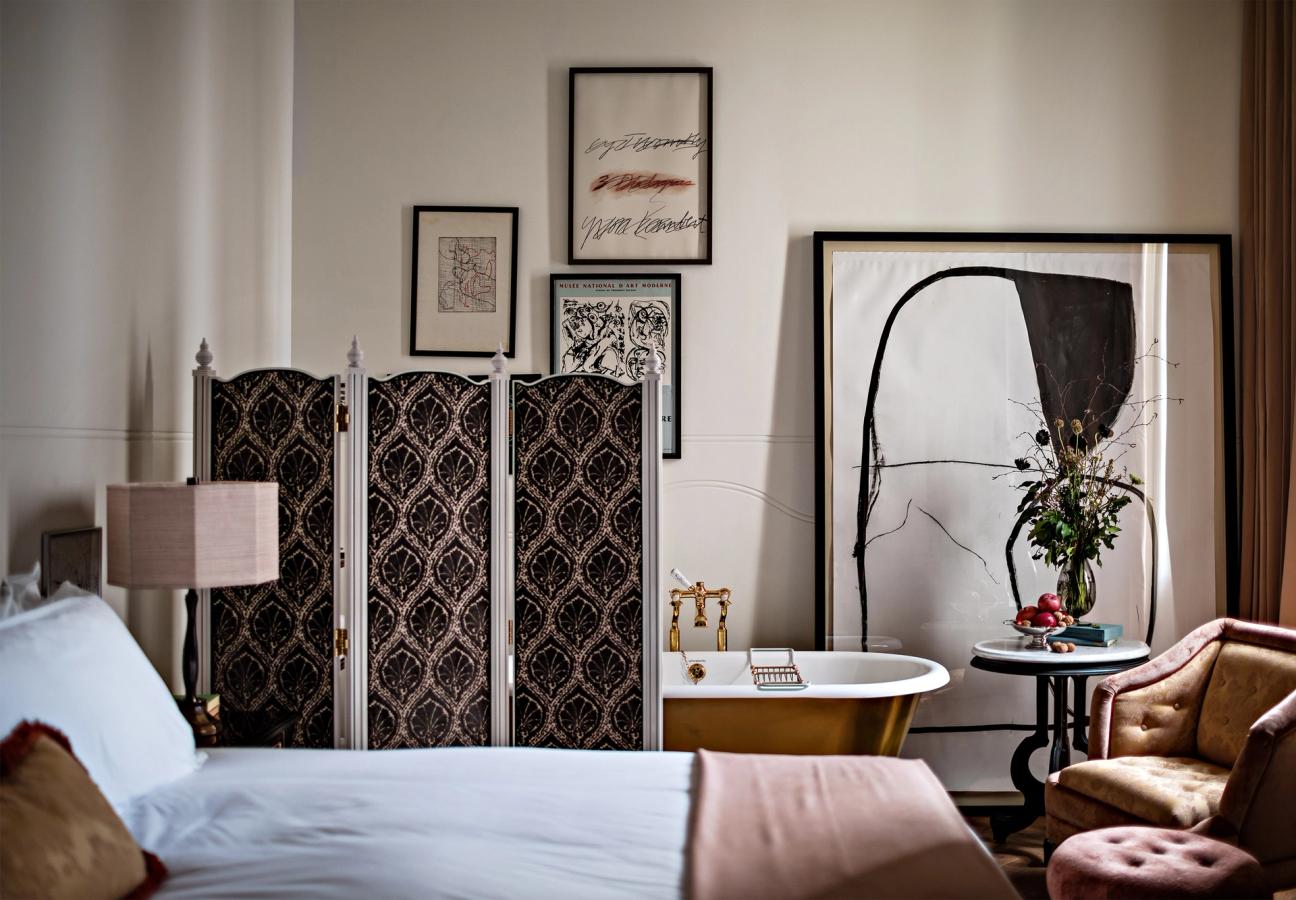
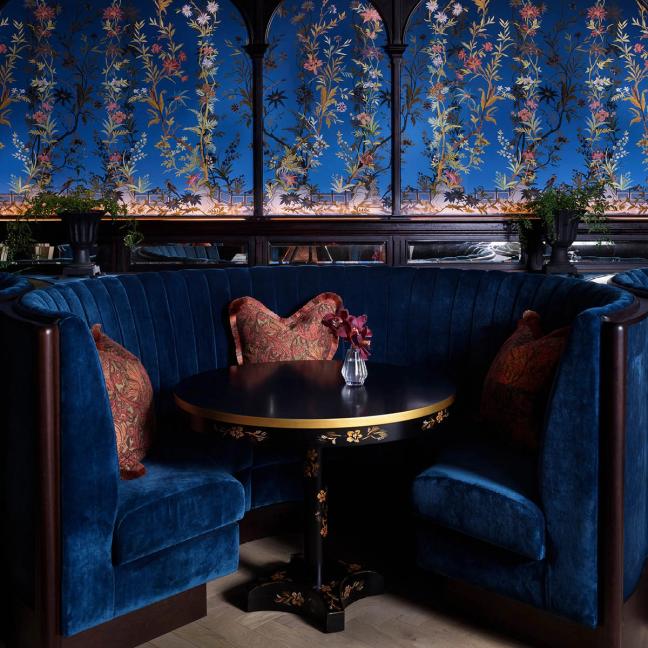
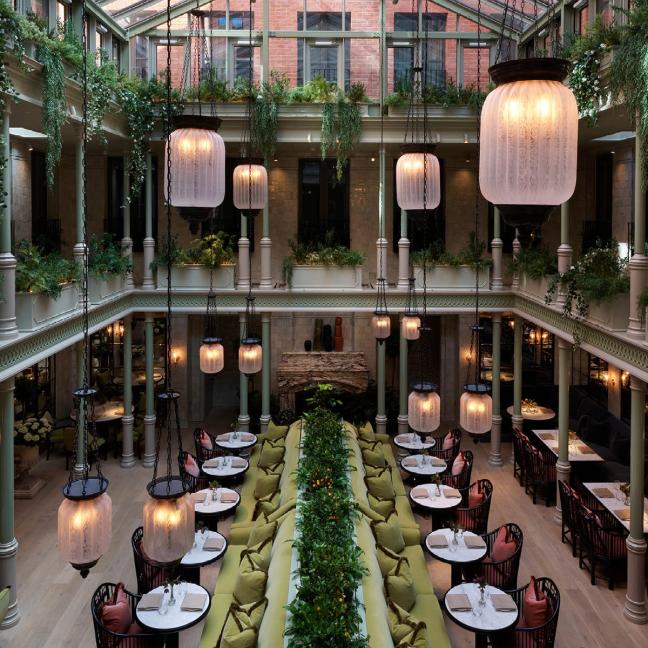
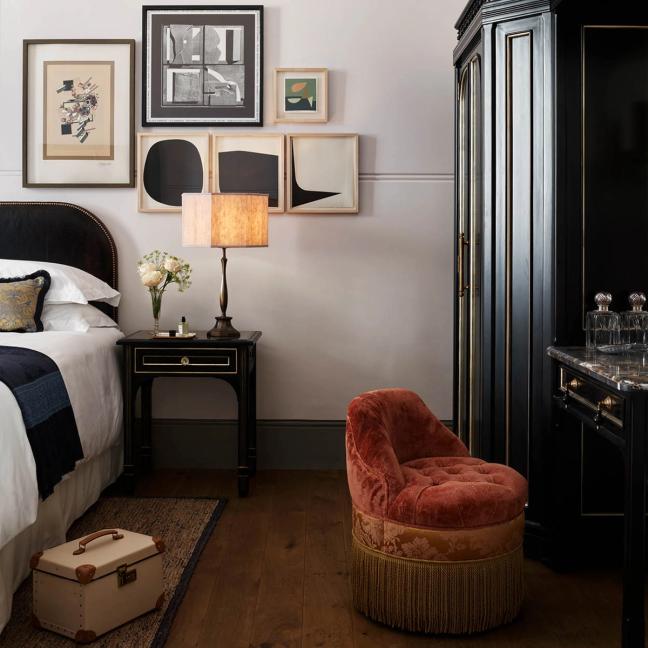
It is really, really easy to love the NoMad, Covent Garden’s marquee hotel whose setting across a former magistrates court and police station creates what might be the city’s closest thing to a bookable film set. The cinematic effect is evident in the lyrical flow of the building, with the dark, moody lobby bleeding into the atrium restaurant – sharing plates, such as the guinea fowl, have proved to be popular within the gourmand scene – and the never-ending maze-like warren of subterranean bars and drinking nooks extends the art-directed feel. Abstract paintings and wonderful illustrations are hooked to the walls. There’s a bar at the entrance modelled as if it were a library. And each of the 91 pads, overseen by Roman and Williams, are a considered collision of Victoriana with the American jazz age: bathrooms done out in Carrara marble and mosaic tiles; rotary dial phones by the bed; vanities and club chairs; and headboards in embossed leather.
If you need further confirmation that this is the place where London’s bright young things honeypot, make a beeline to Side Hustle, where the agave-based spirits are the draw for the Friday nighters; the Sergeant Pepper is the stuff of local legend.
- 28 Bow Street, WC2E 7AW, hilton.com
45 Park Lane
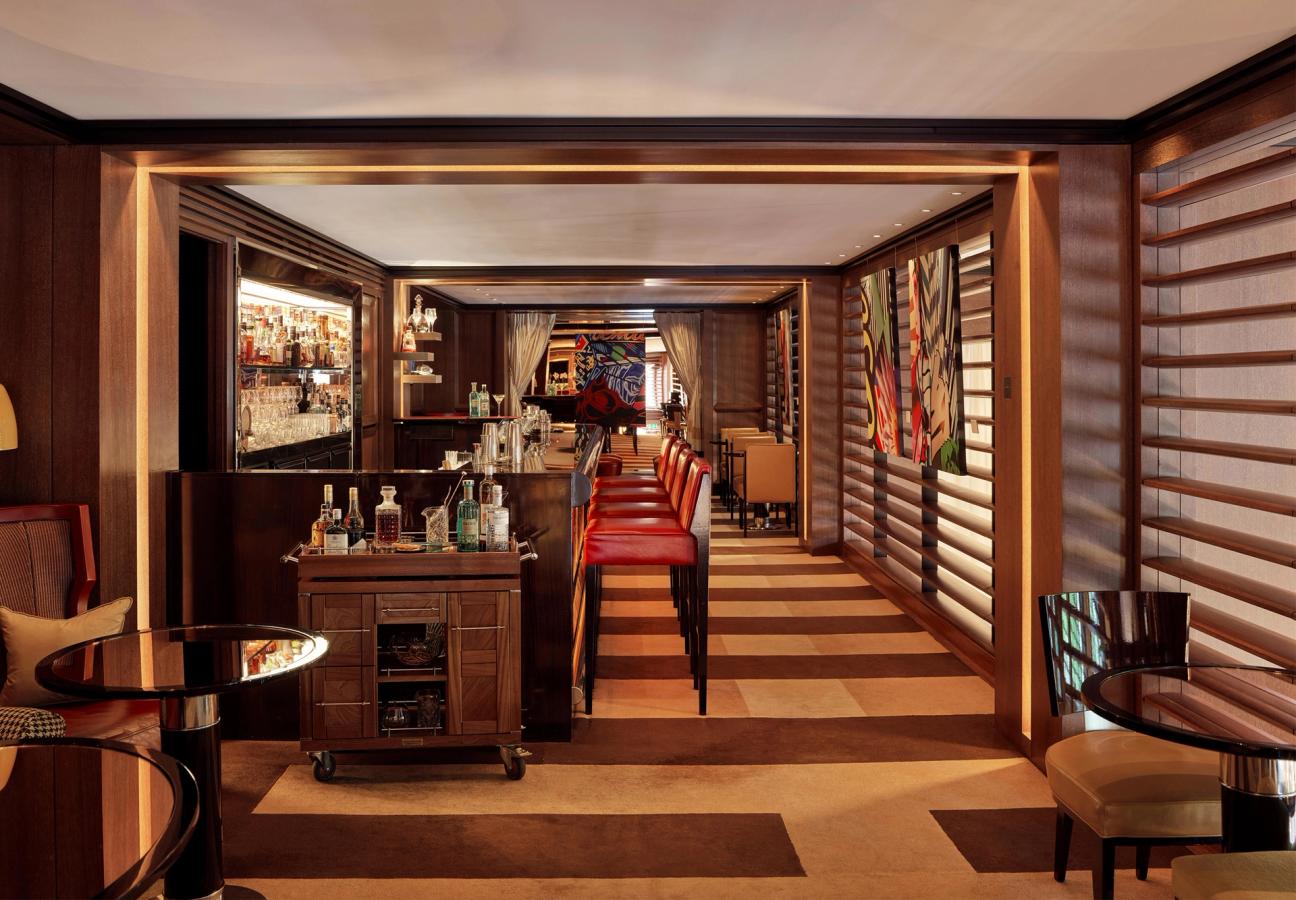
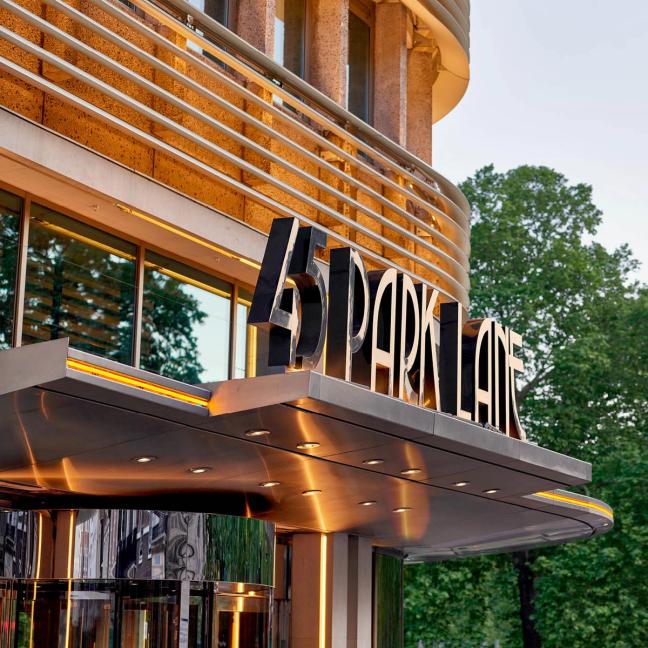
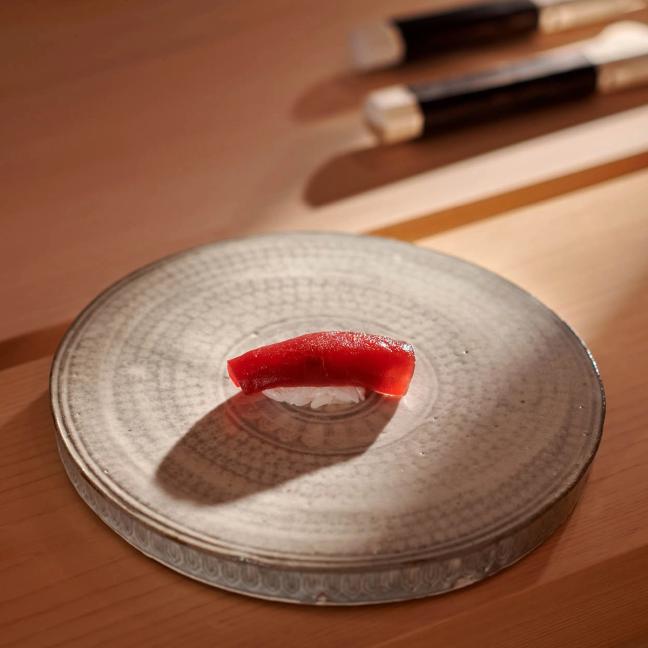
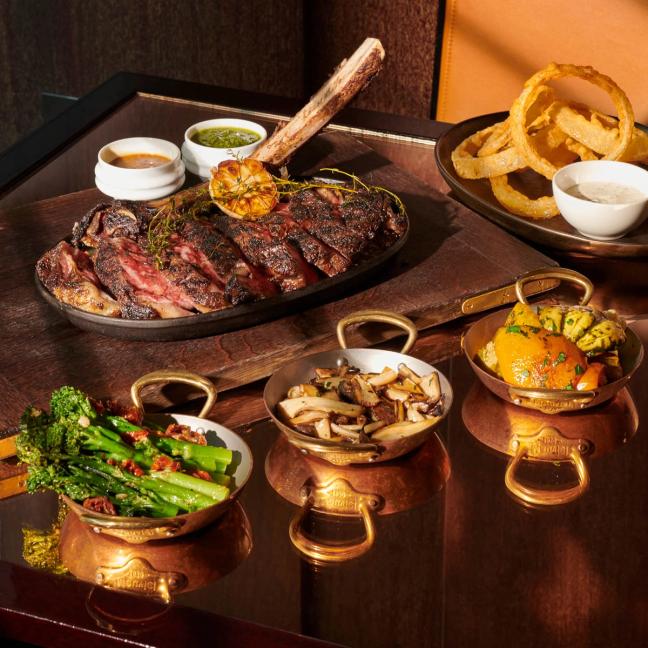
You’ll make your way to this fumey, always-in-motion spot on Park Lane, move straight into the ground-level Cut, Wolfgang Puck’s shrine to the glories of great meat – perhaps the closest London has ever gotten to the great American steakhouse – and you’ll steady the senses with an order of the Infinity Martini from the upstairs bar. You’ll peruse the menu, what can only be described as a sort of directory of beef from across the world – sirloins from America, Australian ribeyes, Japanese cuts sourced from Kagoshima, dry-aged perfection from Britain – and you’ll tell the server how you’d like the chef to cook your cut of choice. There will be sides of puréed potato, wild mushrooms and creamed spinach, lobes of foie gras, and bone marrow seeping from its ends. There might be a chocolate soufflé or burnt Basque cheesecake – or both – to end things off. And you’ll heave yourself into your room afterwards, wash away the sins of the evening, look hazily around the art deco stylings of the fit-out, and fall into the soft pleasures of the Vispring mattress and Mühldorfer bedding.
In the morning, a trip to the basement gym and the neighbouring pool, which is given a sort of William Morris feel with its floral mosaics, would be a pretty smart move. After all, a three-hour omakase at Sushi Kanesaka awaits.
- 45 Park Lane, London W1K 1PN, dorchestercollection.com
Want more London recommendations? These are the city’s best special-occasion restaurants…
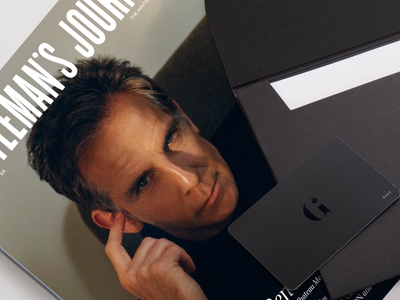
Become a Gentleman’s Journal Member?
Like the Gentleman’s Journal? Why not join the Clubhouse, a special kind of private club where members receive offers and experiences from hand-picked, premium brands. You will also receive invites to exclusive events, the quarterly print magazine delivered directly to your door and your own membership card.
